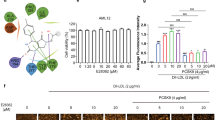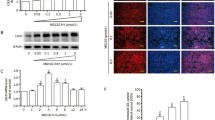Abstract
Proprotein convertase subtilisin/kexin 9 (PCSK9) inhibitors have been shown to regulate lipid metabolism and reduce the risk of cardiovascular events. This study explores the effect and potential mechanism of PCSK9 inhibitors on lipid metabolism and coronary atherosclerosis. HepG2 cells were incubated with PCSK9 inhibitor. ApoE-/- mice were fed with a high fat to construct an atherosclerosis model, and then treated with PCSK9 inhibitor (8 mg/kg for 8 w). PCSK9 inhibitor downregulated microRNA (miRNA)-130a-3p expression in a dose-dependent manner. And, miR-130a-3p could bind directly to the 3' untranslated region (3'-UTR) region of LDLR to down-regulate LDLR expression in HepG2 cells, as confirmed by the luciferase reporter gene assay. In addition, miR-130a-3p overexpression significantly attenuated the promoting effect of PCSK9 inhibitor on LDLR and DiI-LDL uptake in HepG2 cells. More importantly, in vivo experiments confirmed that PCSK9 inhibitor could significantly inhibit miR-130a-3p levels and promote LDLR expression in liver tissues, thus regulating serum lipid profile and alleviating the progression of coronary atherosclerosis. PCSK9 inhibitor could moderately improve coronary atherosclerosis by regulating miR-130a-3p/LDLR axis, providing an exploitable strategy for the treatment of coronary atherosclerosis.






Similar content being viewed by others
Data availability
The datasets used and/or analyzed during the current study are available from the corresponding author on reasonable request.
References
Agbu P, Carthew RW (2021) MicroRNA-mediated regulation of glucose and lipid metabolism. Nat Rev Mol Cell Biol 22(6):425–438
Aguilar-Salinas CA, Gómez-Díaz RA (2021) New therapies for primary hyperlipidaemia. J Clin Endocrinol Metab 107(5):1216–1224
Chang X, Lochner A, Wang HH, Wang S, Zhu H, Ren J, Zhou H (2021) Coronary microvascular injury in myocardial infarction: perception and knowledge for mitochondrial quality control. Theranostics 11(14):6766–6785
Ding Z, Pothineni NVK, Goel A, Lüscher TF, Mehta JL (2020a) PCSK9 and inflammation: role of shear stress, pro-inflammatory cytokines, and LOX-1. Cardiovasc Res 116(5):908–915
Ding Z, Pothineni NVK, Goel A, Lüscher TF, Mehta JL (2020b) PCSK9 and inflammation: role of shear stress, pro-inflammatory cytokines, and LOX-1. Int J Mol Sci 116(5):908–915
Dong J, He M, Li J, Pessentheiner A, Wang C, Zhang J, Sun Y, Wang WT, Zhang Y, Liu J, Wang SC, Huang PH, Gordts PL, Yuan ZY, Tsimikas S, Shyy JY (2020) microRNA-483 ameliorates hypercholesterolemia by inhibiting PCSK9 production. JCI Insight 5(23):e143812
Förstermann U, Xia N, Li H (2017) Roles of vascular oxidative stress and nitric oxide in the pathogenesis of atherosclerosis. Circ Res 120(4):713–735
Guo Y, Tang Z, Yan B, Yin H, Tai S (2022) PCSK9 (Proprotein Convertase Subtilisin/Kexin Type 9) triggers vascular smooth muscle cell senescence and apoptosis: implication of its direct role in degenerative vascular disease. Arterioscler Thromb Vasc Biol 42(1):67–86
Hao Q, Aertgeerts B, Guyatt G, Bekkering GE, Vandvik PO, Khan SU, Rodondi N, Jackson R, Reny JL, Al Ansary L, Van Driel M, Assendelft WJJ, Agoritsas T, Spencer F, Siemieniuk RAC, Lytvyn L, Heen AF, Zhao Q, Riaz IB, Ramaekers D, Okwen PM, Zhu Y, Dawson A, Ovidiu MC, Vanbrabant W, Li S, Delvaux N (2022) PCSK9 inhibitors and ezetimibe for the reduction of cardiovascular events: a clinical practice guideline with risk-stratified recommendations. Endocr Rev 377:e069066
Hilvo M, Dhar I (2022) Primary cardiovascular risk prediction by LDL-cholesterol in Caucasian middle-aged and older adults: a joint analysis of three cohorts. Eur J Prev Cardiol 29(3):e128–e137
Huang M, Wang YZ, Lu J (2021) microRNA-378b regulates ethanol-induced hepatic steatosis by targeting CaMKK2 to mediate lipid metabolism. Bioengineered 12(2):12659–12676
Ji J, Feng M, Niu X, Zhang X, Wang Y (2021) Liraglutide blocks the proliferation, migration and phenotypic switching of Homocysteine (Hcy)-induced vascular smooth muscle cells (VSMCs) by suppressing proprotein convertase subtilisin kexin9 (PCSK9)/ low-density lipoprotein receptor (LDLR). Bioengineered 12(1):8057–8066
Jiang G, Sun C, Wang X, Mei J, Li C, Zhan H, Liao Y, Zhu Y, Mao J (2022) Hepatoprotective mechanism of Silybum marianum on nonalcoholic fatty liver disease based on network pharmacology and experimental verification. Bioengineered 13(3):5216–5235
Leal K, Saavedra K, Rebolledo C, Salazar LA (2021) MicroRNAs hsa-miR-618 and hsa-miR-297 might modulate the pleiotropic effects exerted by statins in endothelial cells through the inhibition of ROCK2 kinase: in-silico approach. Front Cardiovasc Med 8:704175
Liu L, Wang P, Wang YS, Zhang YN, Li C, Yang ZY, Liu ZH, Zhan TZ, Xu J, Xia CM (2021) MiR-130a-3p alleviates liver fibrosis by suppressing HSCs activation and skewing macrophage to Ly6C(lo) phenotype. Front Immunol 12:696069
Liu Y, Luo G, Tang Q, Song Y, Liu D, Wang H, Ma J (2022) Methyltransferase-like 14 silencing relieves the development of atherosclerosis via m(6)A modification of p65 mRNA. Bioengineered 13(5):11832–11843
Ma N, Fan L, Dong Y, Xu X, Yu C, Chen J, Ren J (2021) New PCSK9 inhibitor miR-552-3p reduces LDL-C via enhancing LDLR in high fat diet-fed mice. Pharmacol Res 167:105562
Oleaga C, Shapiro MD, Hay J, Mueller PA, Miles J, Huang C, Friz E, Tavori H, Toth PP, Wójcik C, Warden BA, Purnell JQ, Duell PB, Pamir N, Fazio S (2021) Hepatic sensing loop regulates PCSK9 secretion in response to inhibitory antibodies. J Am Coll Cardiol 78(14):1437–1449
Sánchez-Bacaicoa C, Galán J, Guijarro C (2022) Sustained low-density lipoprotein-cholesterol <70 mg/dl is associated with improved cardiovascular outcomes in the clinical setting. Eur J Clin Invest 52(5):e13732
Saavedra K, Leal K, Saavedra N, Prado Y, Paez I, Ubilla CG, Rojas G, Salazar LA (2022) MicroRNA-20a-5p downregulation by atorvastatin: a potential mechanism involved in lipid-lowering therapy. Int J Mol Sci 23(9):5022. https://doi.org/10.3390/ijms23095022
Scalise V, Sanguinetti C (2021) PCSK9 induces tissue factor expression by activation of TLR4/NFkB signaling. Int J Mol Sci 22(23):12640
Seidah NG, Prat A (2022) The multifaceted biology of PCSK9. Endocr Rev 43(3):558–582
Suvorov A, Naumov V, Shtratnikova V, Logacheva M, Shershebnev A, Wu H, Gerasimov E, Zheludkevich A, Pilsner JR, Sergeyev O (2020) Rat liver epigenome programing by perinatal exposure to 2,2’,4’4’-tetrabromodiphenyl ether. Epigenomics 12(3):235–249
Ubilla CG, Prado Y, Angulo J, Obreque I, Paez I, Saavedra N, Saavedra K, Zambrano T, Salazar LA (2021) MicroRNA-33b is a potential non-invasive biomarker for response to atorvastatin treatment in chilean subjects with hypercholesterolemia: a pilot study. Front Pharmacol 12:674252
Wang Y, Du J, Niu X, Fu N, Wang R, Zhang Y, Zhao S, Sun D, Nan Y (2017) MiR-130a-3p attenuates activation and induces apoptosis of hepatic stellate cells in nonalcoholic fibrosing steatohepatitis by directly targeting TGFBR1 and TGFBR2. Cell Death Dis 8(5):e2792
Wu J, Dong T, Chen T, Sun J, Luo J, He J, Wei L, Zeng B, Zhang H, Li W, Liu J, Chen X, Su M, Ni Y, Jiang Q, Zhang Y, Xi Q (2020) Hepatic exosome-derived miR-130a-3p attenuates glucose intolerance via suppressing PHLPP2 gene in adipocyte. Metabolism 103:154006
Wu NQ, Shi HW, Li JJ (2022) Proprotein convertase subtilisin/kexin type 9 and inflammation: an updated review. Front Cardiovasc Med 9:763516
Xiao F, Yu J, Liu B, Guo Y, Li K, Deng J, Zhang J, Wang C, Chen S, Du Y, Lu Y, Xiao Y, Zhang Z, Guo F (2014) A novel function of microRNA 130a–3p in hepatic insulin sensitivity and liver steatosis. Diabetes 63(8):2631–2642
Xu X, Dong Y, Ma N, Kong W, Yu C, Gong L, Chen J, Ren J (2021) MiR-337-3p lowers serum LDL-C level through targeting PCSK9 in hyperlipidemic mice. Metabolism 119:154768
Yu Y, Tian T, Tan S, Wu P, Guo Y, Li M (2022) MicroRNA-665-3p exacerbates nonalcoholic fatty liver disease in mice. Bioengineered 13(2):2927–2942
Zhou W, Yang F (2022) Circular RNA circRNA-0039459 promotes the migration, invasion, and proliferation of liver cancer cells through the adsorption of miR-432. Bioengineered 13(5):11810–11821
Funding
This study was funded by the Science and Technology Plan Projects of Tianjin Jinnan district (No. 20190104) and Tianjin Key Medical Discipline(specialty) Construction Project [Internal Medicine (Cardiology):TJYXZDXK-055B].
Author information
Authors and Affiliations
Contributions
J.X. and J.Z. wrote the main manuscript text. C.H. and T.L. prepared Figs. 1, 2 and 3. J.Z. and F.Z. prepared Figs. 4 and 5. J.X., D.J. and H.C. prepared Fig. 6. All authors reviewed the manuscript. The authors declare that all data were generated in-house and that no paper mill was used.
Corresponding author
Ethics declarations
Competing interests
The authors declare no competing interests.
Ethics approval
All experiments were approved and conducted by the ethics committee of Tianjin Chest Hospital (TJCH-2021-009).
Disclosure
No potential competing interest was reported by the authors.
Additional information
Publisher's Note
Springer Nature remains neutral with regard to jurisdictional claims in published maps and institutional affiliations.
Rights and permissions
Springer Nature or its licensor (e.g. a society or other partner) holds exclusive rights to this article under a publishing agreement with the author(s) or other rightsholder(s); author self-archiving of the accepted manuscript version of this article is solely governed by the terms of such publishing agreement and applicable law.
About this article
Cite this article
Xu, J., Zuo, J., Han, C. et al. Proprotein convertase subtilisin/kexin 9 inhibitor downregulates microRNA-130a-3p expression in hepatocytes to alleviates atherosclerosis progression. Naunyn-Schmiedeberg's Arch Pharmacol 397, 1727–1736 (2024). https://doi.org/10.1007/s00210-023-02708-x
Received:
Accepted:
Published:
Issue Date:
DOI: https://doi.org/10.1007/s00210-023-02708-x




